March 2020
From Scott McGregor:
|
|
Ada aurantiacaI had one of these a couple years ago, but found it to be virused right after purchasing it and destroyed the plant. Fortunately, the vendor replaced it and the new one is now blooming—one spike open and a couple more to come. These don’t have great form on the flowers, but that color! |
Cattleya (Sophronitis) coccinea 4NA Japanese 4N (tetraploid chromosome) clone of this bright red Sophronitis, the species responsible for the red color in many hybrid Cattleyas. This (and many other red orchids) are difficult to photograph with consumer photo equipment, which are designed to boost red tones to make skin looks “healthier”, and so fully saturate with the bright flower color. I find these are best grown mounted, given bright light and watered frequently with good quality water. Peter Lin suggests they are better in pots to provide more even moisture and humidity—perhaps it depends on whether you’re near the coast or more inland. |
Angraecum erectummall, not very pretty, pale greenish-white upside-down flowers, but hey, it’s an Angraecum, easy to grow outside, and flowers a lot. This is a mini but grows tall with side-roots along the stems, so best grown mounted on tree-fern poles that you can extend as the plant elongates. You can see the roots in the tree fern... |
|
 |
|
Coelogyne cristata v. grandifloraI’ve given up growing the common Coelogyne cristata—love the flowers, but the plants are too rangy and need to be repotted every year or two unless you grow it into a big hanging ball. This is variety “grandiflora” which has even bigger flowers and remains compact, with pseudobulbs growing tightly together. It is well worth the search for this variant. |
|

Comparettia speciosa 'Baker's Beauty' x 'Orange Perfection'Comparettia is a genus of twig epiphytes from the Andes cloud forests, with brightly colored, long-lasting 1” flowers. They need to be grown mounted, and given bright diffuse light and frequent misting/watering with good quality water. C. speciosa (pictured in bloom) and C. macroplectron grow well for me outside. The pic with the buds sadly hanging down is my C. macroplectron that would have opened spectacularly in week or two had I not broken the spike while taking the plant down to look at it :-( |
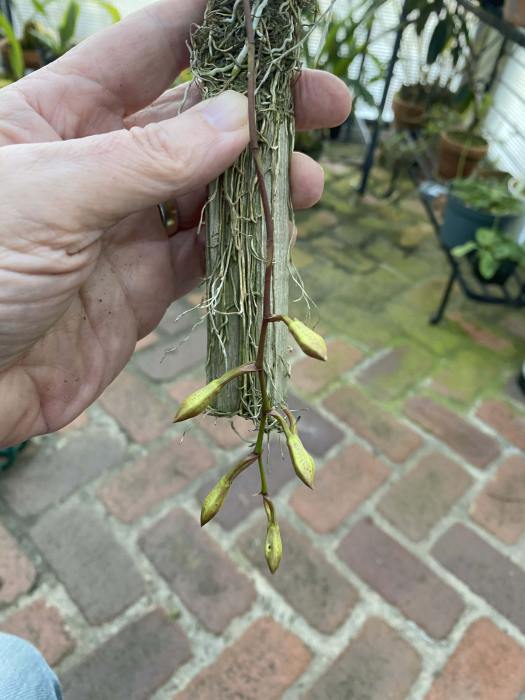 |
 |

Dendrochilum tenellumThis one doesn’t have big flowers, but sure has a lot! I estimate 250-300 spikes with about 40 flowers per spike. I’d hate to be an orchid judge who has to count them!
|
Dendrochilum wenzelii 'Red Sails'A reliable bloomer that makes a nice specimen plant. Tiny red flowers on a long and thin spike, so best to have a lot of them! |

Dracula vampiraAlways a fun one—this species blooms at various times (last time was coincidently Halloween), flower spikes emerging from the bottom of a basket or net pot, and the 6-8” flowers opening facing downward. It grows well outside especially if you’re within a few miles of the coast as it prefers our cool winters and foggy summer mornings, kept shady and moist. Draculas are tougher than you might think from their reputation—I find them easier than e.g. Masdevallias, and had some in flower after our 115F heat wave. Just don’t let them dry out when it is hot and the Santa Ana winds blow. |
Epidendrum porpax (peperomia)Still some more buds yet to open-- the long-lasting, shiny, beetle-like greenish flowers don’t stand out from the foliage but create an interesting display. These grow nicely into specimen plants. Best mounted on a slab or just draped over a mesh pot like this one, with no need for any substrate if you can keep them moist. |
|
Pterostylis curtaNot like the magnificent specimens of Roberta’s (the Pterostylis whisperer), but a nice display of unusual flowers. In previous years I probably kept them dry too long over the summer (as for Thelymitra and Diuris), so started light watering of this Aussie terrestrial early last September and got a much better result. |
|
Isabelia (sophronitella) violaceaA brightly colored attractive miniature, although the flowers only last a few days. I grow this one mounted and very bright. Needs good water |
|
Mediocalcar decoratumAn easy outdoor grower from New Guinea that will creep all over its mount and create a nice specimen over time (this plant is about ten years old). Best grown mounted or draped over a net pot, and with bright light. |
Mediocalcar decoratum (variegated)The variegated version has prettier leaves but fewer flowers. But why choose, grow both! |
Ophrys luteaBright yellow, just opening a first flower after a brief warm and sunny spell. (And a few days later with two flowers open)The flower spikes will elongate over several weeks and open additional flowers sequentially. |
|
Ophrys sphegodesOphrys sphegodes is always my first Ophrys to bloom, usually before the end of January. The spike will elongate over time and open additional flowers, as shown in pic from last year. The flower spike extends and the flowers bloom sequentially over a couple months with several open at a time. |
|
Ophrys tenthrediniferaA pretty and fuzzy Ophrys just opening—the flowers lose their green veining and become pure pink after being open for a few days in sunlight. |
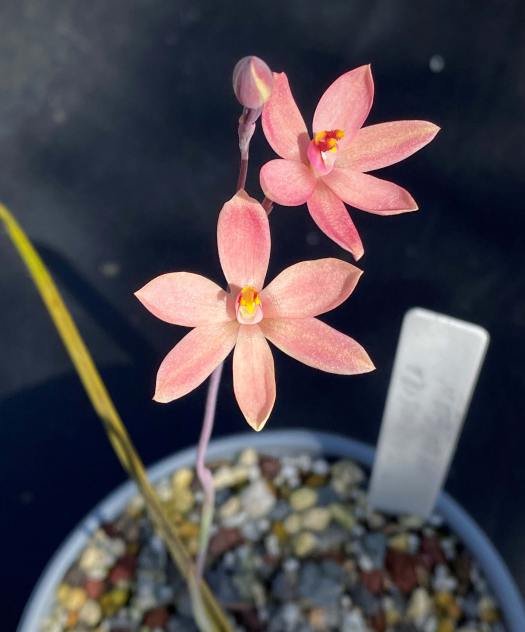
Thelymitra Melon GlowMy first Thelymitra of the season… not a species (primary hybrid, Thel. antennifera x luteocilium) and not blue, but still interesting. |
From Roberta Fox:
|
|
Outside in the Back Yard: |
|
 |
|
Dresslerella caesariataA weird, fuzzy little Pleurothallid that can bloom at any time. It grows shady and damp. |
|
 |
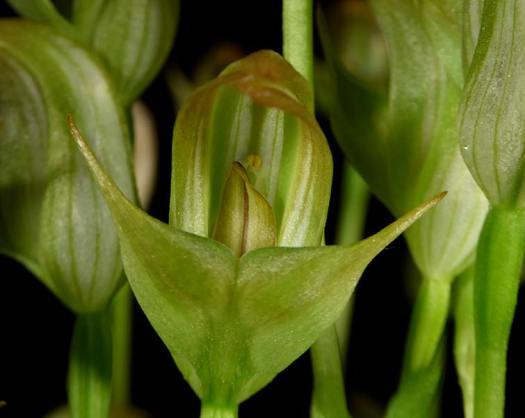
Pterostylis curtaTrue to form, this reached its peak this month. It will soon start to go dormant, but there are still some spikes on the way. |
Restrepia sanguineaThis was the best blooming I have had from this plant in terms of flowers open at the same time. Also, it produced enough flowers that opened at different times to stay in bloom for at least 6 weeks. |
|
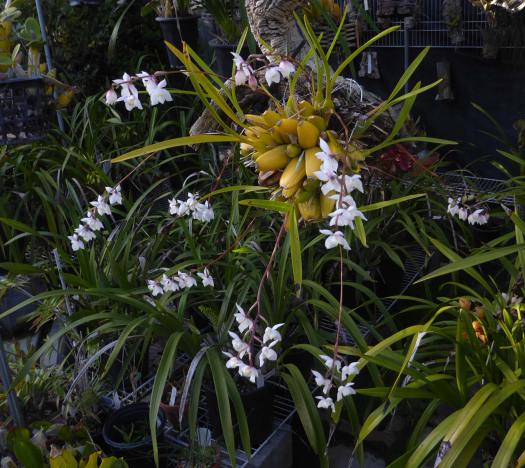
Cuitlauzina (Osmoglossum) puchellumFlowering was a little late this year, but spectacular, as it always is. About 10 spikes. It is extremely fragrant. |
|

Dendrochilum parvulumSerious flower power in a small package. The mount is about 4 inches. There are approximately 60 spikes, flowers about 1/8 inch. I have no idea how many flowrers, they don't all open at once - which extends the blooming. Grows shady and damp. |

 |

Restrepia contortaAt least that is how they both were labled. The one on the left I am pretty sure of. It bloomed with more red this year than last, but the yellow background and spotting is still visible. The one on the right looks to me quite different...but I don't know what factors make a distinct species, many in the genus look similar. |
 |
 |
|
Restrepia jesupianaThis one, from Venezuela, is quite different from any others that I have. Andy Phillips pointed this out to me (not in bloom) on the Society Sales table at the San Francisco show a couple of years ago, and said "You need this one". He was right. This is the first time that it has bloomed for me. |
|
 Epigeneium triflorum var. orientaleFrom Java, at a range of elevation, this blooms at least twice a year, in the late winter and in early fall. It tends to ramble, but I have manage to keep it under control in a basket, growing more vertically (pseudobulbs on top of pseudobulbs) |
|
 |
|
Rossioglossum insleayiNative to Mexico. Flowers have heavy, almost waxy substance. |
|

Trichopilia fragransIt produces several inflorscences over a period of a couple of weeks. It is native to a wide area of Central America, as well as northern South America. It has a spicy fragrance. |
|
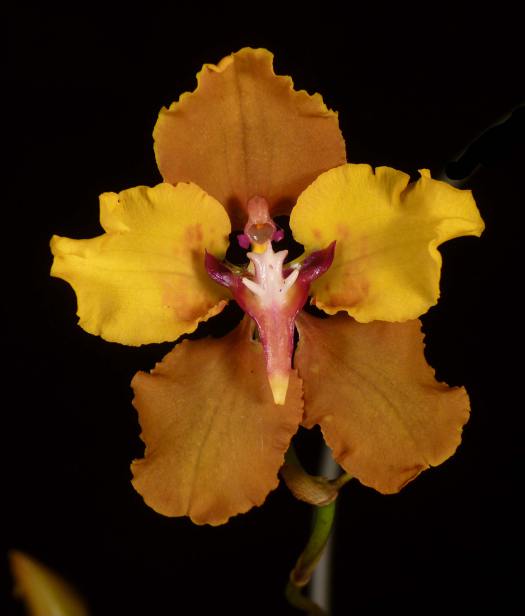
Cyrtochilum matangenseThis is a first bloom. Spike is long, flowers widely spaced. The members of thsi genus do tend to have long, difficult-to-control inflorescences. but these big (2 inch) flowers are quite lovely. |
|

Masdevallia polysticta (yellow form)There is another form, with coerulea caudae. My success rate with the genus is mixed, but this plant is very vigorous, producing multiple spikes reliably. |
 |

Dendrochilum pulcherrimumThis is a relatively small plant, growing in a 4 inch basket. The display of the inflorescences is a bit unruly, but a lot of flowers with nice color. |
 |

Ophrys ariadneThe Mediterranean terrestrials are starting to put on a show. |
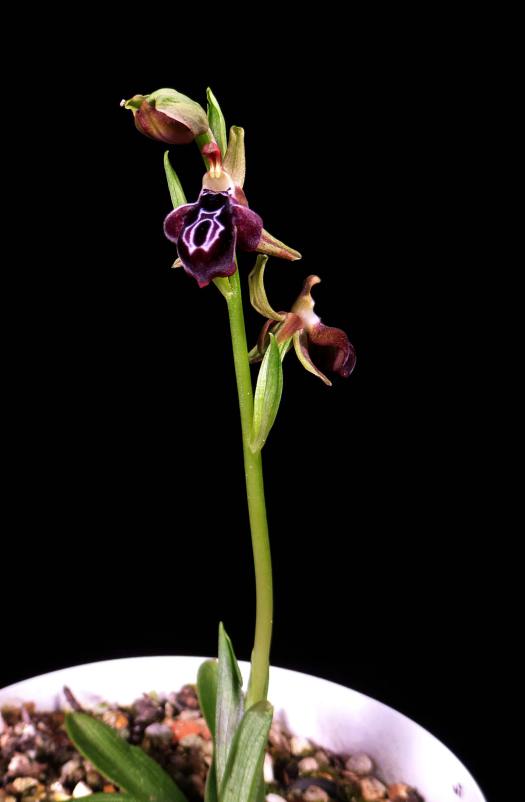 |
|
|
 |
 |
Ophrys mammosaWhen viewed from the side, the source of its name is pretty obvious. |
|
In the greenhouse... |
|

Microterangis hildebrandtiiThis Angraecoid seems to mostly use the basket for support. Along with the pendulous inflorescences, the roots also prefer to run wild. Flowers are about 1/4 inch. |
 |
Zootrophion alvaroiFlowers barely open, with just a slit. The pollinator must be very tiny and attracted to the confined space. To me the flowers look like little lanterns. |
|

Phragmipedium schlimiiThe flower is only about an inch wide, very cute. Like most Phrags, it produces flowers sequentially. |
|



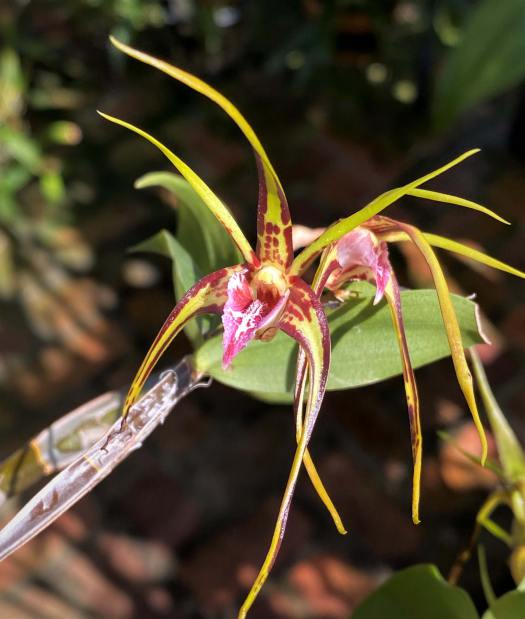






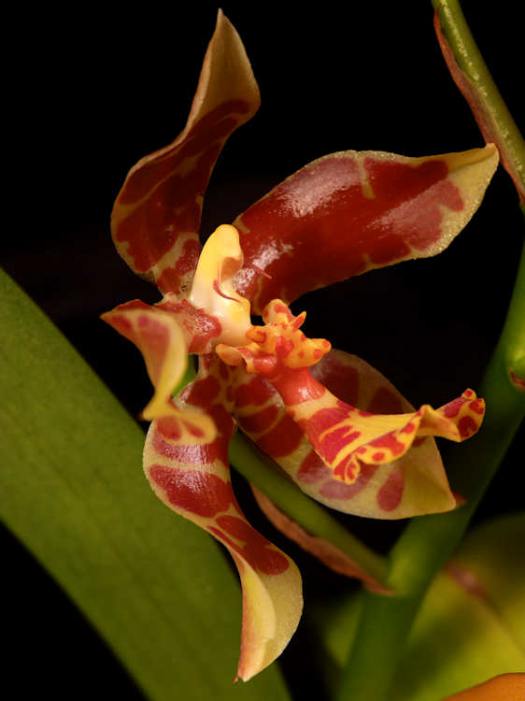


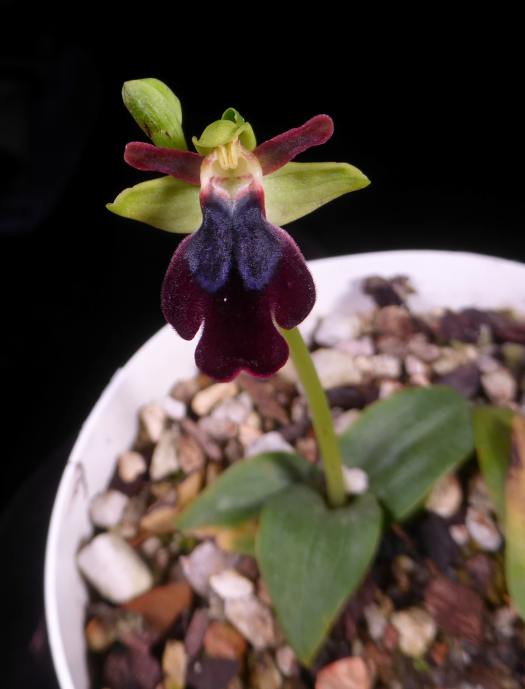 Ophrys iricolor
Ophrys iricolor 


